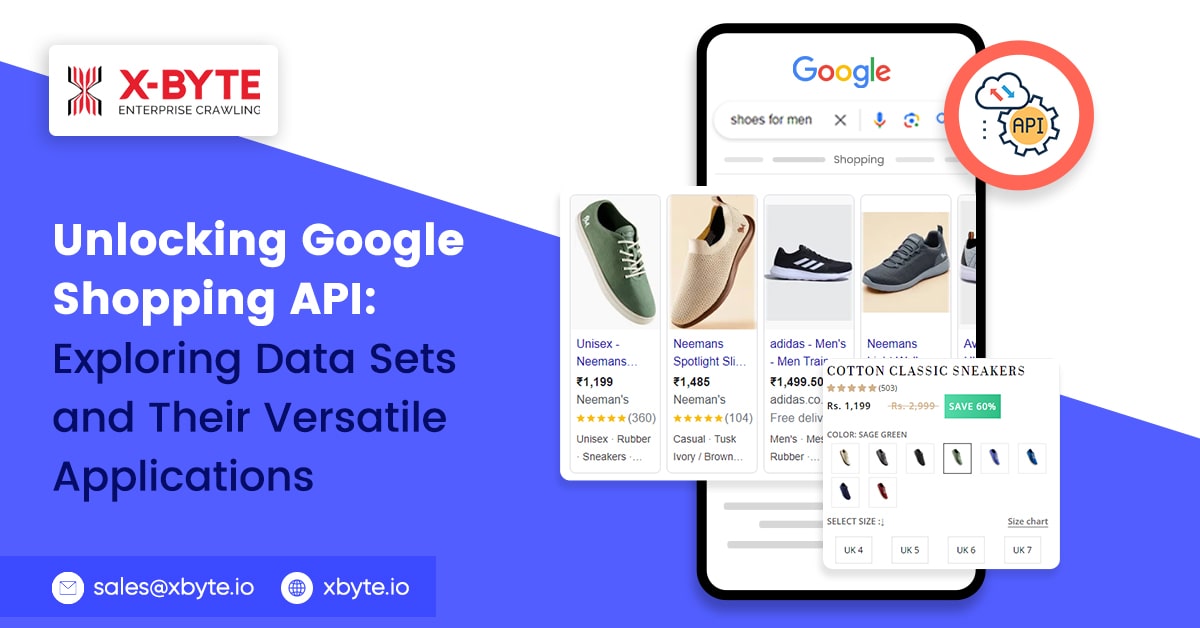
The Google Shopping API gives developers access to a wide range of data sets, such as lists of products, their Google Shopping Prices, and whether or not they are in stock. With this powerful API, developers can scrape Google’s massive database of products, which opens up many options for e-commerce and retail apps. This post will look closely at the Google Shopping API, its many data sets, and how they can be used.
The Google Shopping API lets programmers use several data sets about how items are listed and what they are. These databases have information about goods, such as their names, details, prices, pictures, and seller information. Programmers can extract data about the types of goods, their labels, ratings, feedback, and how they are shipped. They can use these databases to add Google Shopping’s massive collection of products to their software. This lets customers look up and buy things without leaving their user experiences. Coders can use this API to make it easy and convenient for users to buy something.
Google Shopping API and its significance in the eCommerce and retail sectors

The Google Shopping API is essential to the e-commerce industry because it can improve the buying experience for both businesses and customers.
Organizations can connect their goods to the Google Shopping system with the API. This lets them reach many people who might buy from them. Companies can use the API’s data sets to scrape accurate and up-to-date product data, like names, descriptions, prices, and pictures. This ensures that the right products are shown to people looking for relevant goods, increasing exposure and income potential.
The API makes shopping easier for customers by giving them detailed and flexible information about the products they want to buy. Through Google Shopping, customers can look at various goods, compare prices, read reviews, and look at seller information. The API has good searching and sorting features that let users find specific things that meet their needs and preferences.
Google API’s goal in shopping campaigns
Google APIs are an important part of e-commerce because they give businesses the tools and features, they need to market and sell their products on Google’s platforms. The goal of Google APIs for retail projects is to increase sales by bringing in more of the right customers and making businesses’ products and services more visible.
Google APIs make it easy for companies to connect their product details and marketing to Google’s shopping platforms. Some examples of these services are the Google Ads API and the Google Merchant Center API. With these APIs, companies can manage their stock, change prices and availability, keep track of success indicators, and show goods.
By using Google APIs, businesses can make interactive, exciting ads for shopping that customers can see. APIs make it possible for product information to be kept in sync. This makes sure that the information in ads is correct and relevant.
Google APIs also have solid tools for personalization and efficiency. Companies can use APIs to target specific groups, change bids based on their performance, and optimize their marketing efforts for the best return on investment (ROI).
Data Sets Offered by the Google Shopping API
With the Google Shopping API, developers can use various data sets. This helps them add and use product information on their websites or apps.
Product information, which includes features like names, details, prices, etc., is an essential data collection piece. Programmers can use this information to give customers complete, up-to-date lists of accurate and exciting products.
The ratings and reviews of goods are another vital source of information. Programmers can extract data about how customers rate, rank, and review. This information helps people make smart decisions by telling them how reliable a product is and how much people like it.
On the Google Shopping API, you can also scrape the data sets that cover product groups and features. Programmers can extract information about how things are put into groups so that they can screen and organize their apps more efficiently. Also, the name, size, color, and material give you more information about an item. This lets people narrow their searches and find exactly what they want.
Potential Applications of the Google Shopping API Data Sets
The information sets from the Google Shopping API can be used in many exciting ways by online retail and e-commerce business programmers. Some of the most important ways this can help are:
Programmers are making systems that let customers compare things from different stores. They use knowledge about the product, customer feedback, and assessments to make these.
Custom Item Suggestions: Using the item’s data to analyze consumer tastes and behavior, programmers can make suggestion engines that give customers unique product ideas. These suggestions depend on how the user surfs the web, what they buy, and what the product is like.
Options for stock management: Businesses can connect their programs for managing stock to the Google Shopping API. This is possible because of product stock data. This lets you make changes to your inventory in real time, so you don’t oversell or show things that are sold out.
Cost Comparison: Using a product’s specs and price information, programmers can make websites that show how much the same thing costs at different stores. Users can use this way to save money and find the best deals.
Considering a few things before using the Google Shopping API
Before programmers use the Google Shopping API, they must consider a few things. Here are the most important things to think about:
API Usage Instructions:
Understanding all of Google’s API documentation and rules is essential. Know Google’s usage rules, conditions, and any limits that have been put in place. Make sure to follow the API standards to avoid any problems.
Identification and Accessibility:
Before using the API, ensure you know how to authenticate yourself and have all the information you need. Follow Google’s authorization steps to get to and use API data sets appropriately.
Data Utilization and Security:
- Recognize any limits on how much you can use or how much you can pay that the API may have put in place.
- Recognize the API entry costs, such as the cost of any questions or data access and the cost structure.
- Organize your spending so you don’t have to pay extra or deal with other problems because you exceeded your budget.
Utilization Restrictions and Prices:
- Recognize any limits on how much you can use or how much you can pay that the API may have put in place.
- Recognize the API entry costs, such as the cost of any questions or data access and the cost structure.
- Organize your spending so you don’t have to pay extra or deal with other problems because you exceeded your budget.
Implementing good ways to handle failures and monitoring how APIs are used can help you find and fix problems quickly. Check Google’s website often for updates or alerts about changes to the API.
Examples of usages of Google Shopping API
Here are some ways in which the Google Shopping API can be useful:
Goods Navigation: Using information about and features of a product, designers can make search engines or systems for making suggestions. These systems let people choose goods based on their tastes, search histories, and Internet use.
Inventory Control Platforms: Businesses can connect the Google Shopping API to their inventory control platforms to share up-to-date information about available items and how much they cost. This ensures the stock is managed correctly and keeps things from being oversold or shown when they are out of stock.
Ad Campaign Control: Marketers can monitor and improve their buying ads using the Google Shopping API. They can make exciting ads for shopping, change ideas, and check how healthy campaigns work if they have access to product information.
Data analysis: By looking at the Google Shopping API’s data sets, designers can learn more about customer habits, the market’s workings, and the best-selling goods. This info can help a business make data-based decisions and improve its pricing methods.
Conclusion
The Google Shopping API is an excellent tool if you know how to use it. These APIs must be used by developers or companies that want to take advantage of all the benefits of Google Shopping platforms. They make it easy to make your website fit in with the Google experience.
